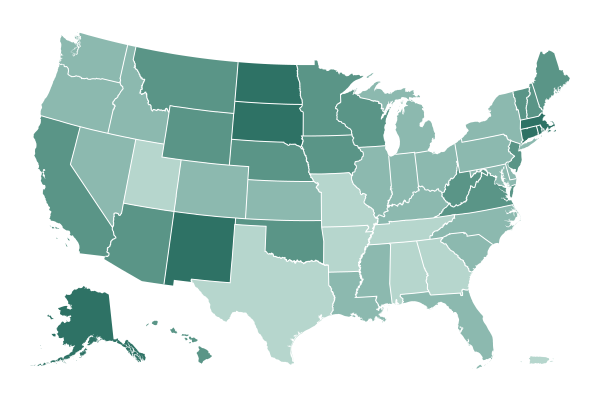As countries jostle to secure enough vaccine doses to help put an end to the pandemic, a new competition is unfolding: for syringes to administer them with.
There is simply not enough of them.
Officials in the United States and the European Union have said they need more. And in January, Brazil restricted exports of syringes and needles when its vaccination efforts fell short.
Further complicating the challenge, not just any syringe will do the trick.
Japan revealed last month that it might have to discard millions of doses of the Pfizer-BioNTech vaccine if it couldn’t secure enough syringes able to draw out a sixth dose from vials. In January, the Food and Drug Administration advised health care providers in the United States that they could extract more doses from the Pfizer vials after hospitals there discovered that some contained enough for a sixth — or even a seventh — shot.
“A lot of countries were caught flat-footed,” said Ingrid Katz, the associate director of the Harvard Global Health Institute.
The world needs between eight billion and 10 billion syringes for Covid-19 vaccinations alone, experts say.
In previous years, only 5 percent to 10 percent of the estimated 16 billion syringes used worldwide were meant for vaccination and immunization, said Prashant Yadav, a senior fellow at the Center for Global Development, a think tank in Washington, and an expert on health care supply chains.
Wealthier nations like the United States, Britain, France and Germany pumped billions into developing the vaccines, but little public investment has gone into expanding manufacturing for syringes, Mr. Yadav said.
The industry has ramped up to meet demand.
Becton, Dickinson and Company, which is the world’s largest manufacturer of syringes and is based in New Jersey, said it was producing 2,000 each minute to meet orders of more than a billion.
The United States is the world’s largest syringe maker by sales, according to Fitch Solutions, a research firm. The United States and China are neck and neck in exports, with combined annual shipments worth $1.7 billion.
While India is a small player globally, Hindustan Syringes & Medical Devices in Ballabgarh, one of the world’s largest syringe makers, sunk millions of dollars into preparing its syringe factories for the vaccination onslaught.
Rajiv Nath, the company’s managing director, added 500 workers to his production lines, which crank out more than 5,900 syringes per minute at factories spread over 11 acres in a dusty industrial district outside New Delhi. With Sundays and public holidays off, the company churns out nearly 2.5 billion a year, and plans to scale up to three billion by July.
Mr. Nath has sold 50 million to the Japanese government, he said, and over 400 million to India for its Covid-19 vaccination drive, one of the largest in the world.
More are waiting in line, including UNICEF. In November, the United Nations agency for children reached out to say that it was desperately seeking syringes. And not just any would do. They had to be smaller than usual, and break if used a second time, to prevent spreading disease through accidental reuse.
Most important: UNICEF needed them in vast quantities. Now.
“I thought, ‘No issues,’” said Mr. Nath. “We could deliver it possibly faster than anybody else.”
The company is set to begin shipping 3.2 million of those syringes soon, UNICEF said, provided they clear another quality check. And Mr. Nath has offered to produce about 240 million more.
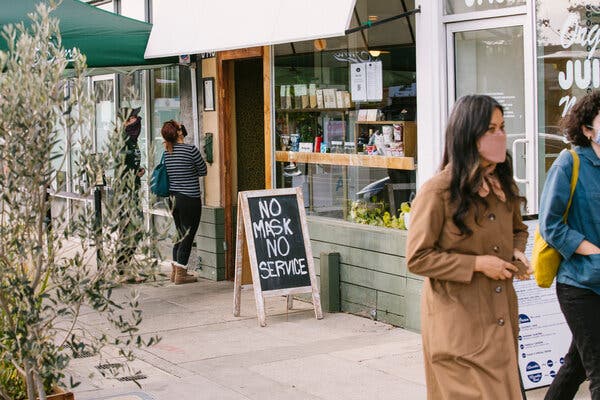
As officials in Texas and Mississippi lifted statewide mask mandates, researchers at the Centers for Disease Control and Prevention offered, in a new study on Friday, fresh evidence of the importance of mask use. The study reported that mask-wearing was linked to fewer infections with the coronavirus and Covid-19 deaths in counties across the United States.
The researchers also found that counties opening restaurants for on-premises dining — indoors or outdoors — saw a rise in daily infections about six weeks later, and an increase in Covid-19 death rates about two months later.
The study does not prove cause and effect, but the findings square with other research showing that masks prevent infection and that indoor spaces foster the spread of the virus through aerosols, tiny respiratory particles that linger in the air.
“You have decreases in cases and deaths when you wear masks, and you have increases in cases and deaths when you have in-person restaurant dining,” Dr. Rachel Walensky, the director of the C.D.C., said on Friday. “And so we would advocate for policies, certainly while we’re at this plateau of a high number of cases, that would listen to that public health science.”
The findings come as city and state officials nationwide grapple with growing pressure to reopen schools and businesses amid falling rates of new cases and deaths. Officials have recently allowed for limited indoor dining in New York City. And on Thursday, Connecticut’s governor said would be ending capacity limits later this month on restaurants, gyms and offices. Masks remain required in both places.
Though coronavirus cases and deaths are down significantly across the country compared to the devastating peaks around the holidays, President Biden’s health advisers have said in recent days it is not the time to relax. According to a New York Times database, the seven-day average of new cases is 62,924 a day, as of Thursday. While that average is down 14 percent from two weeks earlier, the figure remains near the level of new cases reported during the highest peak last summer. Though fatalities have started falling, in part because of the vaccination campaign at nursing homes, it remains routine for 2,000 deaths to be reported in a single day.
Mr. Biden on Wednesday criticized the decisions by the governors of Texas and Mississippi to lift statewide mask mandates and reopen businesses without restrictions, calling the plans “a big mistake” that reflected “Neanderthal thinking.”
The president, who has asked the American people to wear a mask for his first 100 days in office, said it was critical for public officials to follow the guidance of doctors and public health leaders as the coronavirus vaccination campaign gains momentum.
According to the C.D.C., about 54 million people have already received at least one dose of a Covid-19 vaccine, as of Thursday. Mr. Biden’s power to enforce mask-wearing is limited to the federal sphere; he has ordered a mask requirement for anyone on federal property, and his administration is asking people to wear masks regardless of local mandates.
“It may seem tempting, in the face of all of this progress, to try to rush back to normalcy as if the virus is in the rear view mirror. It’s not,” Andy Slavitt, a White House pandemic adviser, said on Friday. “Why somebody wouldn’t take advantage of a small intervention to save people’s lives, that would be surprising.”
Masks have been proven to protect people from catching the virus. For a closer look, C.D.C. researchers examined the association between mask mandates and indoor or outdoor restaurant dining and coronavirus infections and deaths last year between March 1 and Dec. 31. The agency relied on county-level data from state government websites and measured daily percentage growth in coronavirus cases and deaths.
Infections and deaths declined after counties mandated mask use, the agency found. Daily infections rose about six weeks after counties allowed restaurants to open for dining on the premises, and death rates followed two months later.
The report’s authors concluded that mask mandates were linked to statistically significant decreases in coronavirus cases and death rates within 20 days of implementation. On-premises dining, whether indoors or outdoors, at restaurants was associated with increases in case and death rates within 41 to 80 days after reopenings.
“State mask mandates and prohibiting on-premises dining at restaurants help limit potential exposure to SARS-Cov-2, reducing community transmission of Covid-19,” the authors wrote.
Shortly after publishing the report, the C.D.C. amended it to urge restaurants that resume on-premises dining to follow the C.D.C.’s guidelines for reducing transmission in restaurant settings.
That includes “everything from having staff stay home when they show signs of Covid or have tested positive or been in contact with someone who has Covid, and requiring masks among employees as well as customers who are not actively eating or drinking,” said Gery P. Guy, a health scientist with the C.D.C. Covid response team and the study’s corresponding author.
Other steps that can be taken are ensuring adequate ventilation, providing options to eat outdoors, spacing customers six feet apart, encouraging frequent hand washing and carrying out frequenting sanitizing of surfaces that are touched a lot, such as cash registers or pay terminals, door handles and tables.
“The message is, if restaurants are going to open for on-premise dining, it’s important to follow C.D.C. guidelines to do so safely and effectively,” Dr. Guy said.
Eileen Sullivan contributed reporting.

The images above tell a story of disparity of the starkest sort.
“People of color are getting vaccinated at rates below their representation of the general population,” Dr. Marcella Nunez-Smith, the chair of President Biden’s coronavirus equity task force, said at a recent forum on the vaccine. “This narrative can be changed. It must be changed.”
In recent days, The New York Times’s graphics team set out to measure how equitably Covid-19 vaccines were being distributed across the United States.
The data is imperfect. As of March 3, only 38 states publicly shared race and ethnicity data for vaccinated people.
Further complicating the task, different jurisdictions define race and ethnicity categories in slightly different ways — and with different levels of completeness. In some states, as much as a third of vaccinations were missing race and ethnicity data.
But a disturbing portrait nevertheless emerged.
Communities of color, which have borne the brunt of the Covid-19 pandemic in the United States, have also received a smaller share of available vaccines. The vaccination rate for Black Americans is half that of white people, and the gap for Hispanic people is even larger, The Times analysis found.
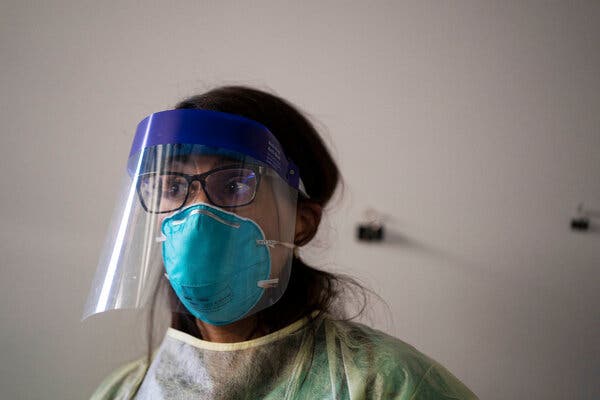
Scientists in Oregon have identified a homegrown version of a fast-spreading variant of the coronavirus that first surfaced in Britain — but this one has a mutation that may make the variant less susceptible to vaccines.
The researchers have so far found just a single case of this formidable combination, but genetic analysis suggested that the variant had been acquired in the community and did not arise in the patient.
“We didn’t import this from elsewhere in the world — it occurred spontaneously,” said Brian O’Roak, a geneticist at Oregon Health and Science University who led the work. He and his colleagues participate in the Centers for Disease Control and Prevention’s effort to track variants, and they have deposited their results in databases shared by scientists.
The variant originally identified in Britain, called B.1.1.7, has been spreading rapidly across the United States, and accounts for at least 2,500 cases in 46 states. This form of the virus is both more contagious and more deadly than the original version, and is expected to account for most infections in America in a few weeks.
The new version that surfaced in Portland has the same backbone as B.1.1.7, and the mutation it carries — E484K, or “Eek” — is one seen in variants of the virus circulating in South Africa, Brazil and New York City.
Lab studies and clinical trials in South Africa indicate that the Eek mutation renders the current vaccines less effective by blunting the body’s immune response. (The vaccines still work, but the findings are worrying enough that Pfizer-BioNTech and Moderna have begun testing new versions of their vaccines designed to defeat the variant found in South Africa.)
The B.1.1.7 variant with Eek also has emerged in Britain, but the virus identified in Oregon seems to have evolved independently, Dr. O’Roak said.
Dr. O’Roak and his colleagues found the B.1.1.7 variant with Eek among coronavirus samples collected by the Oregon State Public Health Lab from an outbreak in a health care setting. Of the 13 test results they analyzed, 10 turned out to be B.1.1.7 alone, and one the combination.
Experts said the discovery was not surprising, because the Eek mutation has arisen in forms of the virus all over the world. But the mutation’s occurrence in B.1.1.7 is worth watching, they said.
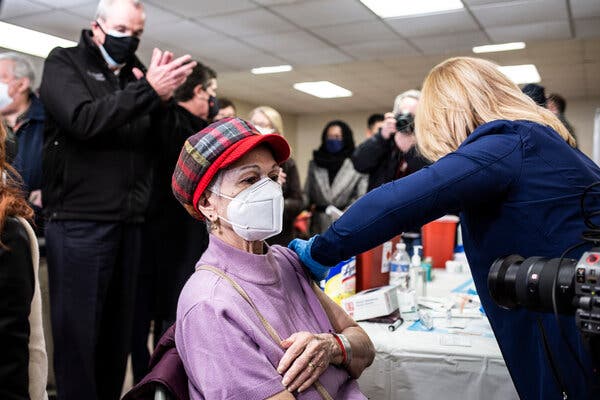
Vaccine hesitancy has been a concern among U.S. public health experts for months now. But evidence increasingly suggests that as vaccination rates increase, many unvaccinated Americans are becoming more comfortable with the idea of receiving the shot themselves.
The proportion of adults in the country who intend to get vaccinated has increased significantly over the last several months, according to a survey released Friday by the Pew Research Center. Sixty-nine percent of the public now plans to get vaccinated — or already has — up from 60 percent who said in November that they intended to pursue it.
The issue has become more partisan over time, however. The new survey finds a 27-percentage point political gap, with 83 percent of Democrats saying they plan to get the vaccine or have already received it, compared to just 56 percent of Republicans.
Despite the divides, the new survey bolsters optimism that overall, Americans are increasingly open to receiving the vaccine. About 54 million people — 16 percent of the population — had received at least one dose of a Covid-19 vaccine as of Thursday, according to the Centers for Disease Control and Prevention.
The survey also notes that 47 percent of Black Americans plan to get vaccinated and 15 percent say they already have been. Taken together, that is a sharp increase from the 42 percent who said in November they intended to be vaccinated.
Black and Latino people in the United States are being vaccinated at lower rates in part because they face obstacles like language barriers and inadequate access to digital technology, medical facilities and transportation. Mistrust in government officials and doctors also plays a role, experts say, and is fed by misinformation that is spread on social media. President Biden has made equity a major focus of his pandemic response, saying he wants pharmacies, mobile vaccination units and community clinics that help underserved communities to help increase the pace of vaccinations.
Overall, those surveyed by Pew who say they do not plan to get the vaccine cite reasons including concerns about side effects and a feeling that the vaccines were developed too quickly. Others say they are waiting for more information about how well they work.
The Pew results echo a survey released last week from the Kaiser Family Foundation that found vaccine hesitancy declining among most demographic groups. That survey also found a significant political gap, but noted that both Democrats and Republicans were significantly more likely to say they intended to get the vaccine now than in December.
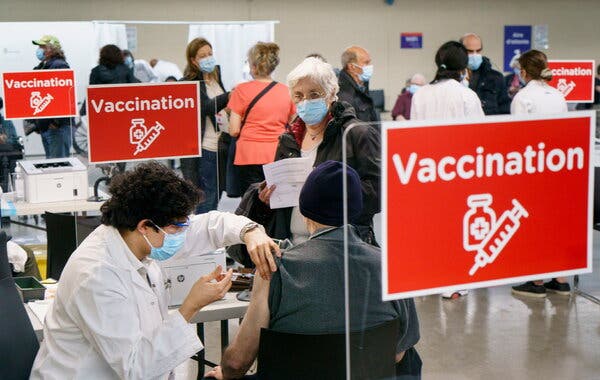
Canada’s health regulator on Friday authorized the use of Johnson & Johnson’s single-dose vaccine. The move now gives the country, which has experienced a slow start to vaccinations, four inoculations to choose from.
“This is great news,” Prime Minister Justin Trudeau said at a news conference. He offered no projected date for the first deliveries.
Health Canada officials said that the vaccine has an overall effectiveness of 66.9 percent, much lower than the efficacy rates reached by Pfizer and Moderna vaccines. But it is similar to those vaccines in having a powerful ability to prevent severe disease, hospitalizations and death.
The United States and Bahrain have also authorized the Johnson & Johnson vaccine.
Production delays with the Pfizer and Moderna vaccines, combined with relatively modest initial shipments, have led to frustration among many Canadians — and put political pressure on Mr. Trudeau as Canada’s vaccination rate fell far behind that of the United States, Britain and other countries. As of Friday, 2.86 percent of all Canadians have received at least one dose.
Canada has ordered 10 million doses of the Johnson & Johnson vaccine and has options for another 28 million, a combined number that is slightly higher than the country’s population.
Depending on its arrival and combined with the need to only administer a single shot, the new vaccine may help significantly boost the country’s vaccination rate. The Johnson & Johnson vaccine also does not require extremely low storage temperatures, as the Pfizer vaccine does, making it easier to distribute to remote communities in Canada’s north.
Mr. Trudeau said that Pfizer would send 1.5 million doses, originally scheduled for delivery in the summer, over the next two months. Canada also received its first shipment this week of a version of the AstraZeneca vaccine, developed by the Serum Institute of India.
The Canadian government had initially promised to obtain six million doses of vaccines by the end of March. The new Pfizer schedule combined with AstraZeneca shipments, officials said, will raise that figure to eight million.
Since Johnson & Johnson revealed data showing that its vaccine, while highly protective, had a slightly lower efficacy rate than the ones produced by Moderna and Pfizer-BioNTech, health officials have feared that the new shot might be viewed by some Americans as the inferior choice.
But the early days of its rollout suggest something different: Some people are eager to get it because they want the convenience of a single shot.
And public health officials are enthusiastic about how much faster they can get the single-shot doses distributed, particularly in vulnerable communities that might not otherwise have access to vaccine.
“This is a potential breakthrough,” said Dr. Joseph Kanter, the top health official in Louisiana.
With its first allotted doses, that state is holding a dozen large Johnson & Johnson vaccination events at civic centers and other public places, modeled after what has worked for flu vaccines.
Only four million doses were shipped this week, and the company’s manufacturing lags mean that it will be at least a month before states start receiving significant supplies. But as Johnson & Johnson ramps up production over the next few months, Dr. Kanter said, the vaccine will allow his state to slash costs for staffing and operations related to second doses.
“The J. & J. vaccine brings a lot to the table,” he said.
Judged by how well it prevents severe disease, hospitalization and death, the Johnson & Johnson shot is comparable to those made by Moderna and Pfizer-BioNTech. And although it has a lower overall efficacy rate in the United States — 72 percent, compared with roughly 95 percent for the others — experts say that comparing those numbers is problematic because the companies’ trials were conducted in different places and at different times.
Besides being a single-dose shot, the Johnson & Johnson vaccine offers another benefit: It can be kept at normal refrigeration temperatures for three months. That makes it ideal for distribution at nonmedical sites such as stadiums and convention centers. The vaccine has caused a surge of excitement at small, independent pharmacies, too.
Many state health officials said they were focused on getting the vaccine to people who might be harder to reach for a second dose, such as those who are homeless or on the verge of release from prison.
Patricia Cooper, a teacher in Washington, D.C., said that President Donald J. Trump’s efforts to claim credit for a vaccine last year and the label “emergency use authorization” had suggested to her that the federal government may have rushed its reviews of vaccines. That left her feeling jittery about their safety.
But Ms. Cooper said she was eager to get a shot, especially the Johnson & Johnson one.
“This one is more appealing to me,” she said. “Who likes to get stuck more than once?”
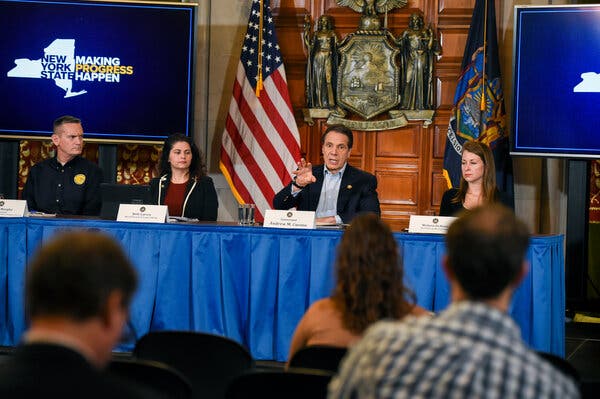
Top aides to Gov. Andrew M. Cuomo were alarmed: A report written by state health officials had just landed, and it included a count of how many nursing home residents in New York had died in the pandemic.
The number — more than 9,000 by that point in June — was not public, and the governor’s most senior aides wanted to keep it that way. They rewrote the report to take it out, according to interviews and documents reviewed by The New York Times.
The extraordinary intervention, which came as Mr. Cuomo was starting to write a book on his pandemic achievements, was the earliest act yet known in what critics have called a monthslong effort by the governor and his aides to obscure the full scope of nursing home deaths in the state. The episode reflects the lengths to which Mr. Cuomo has gone to control data, brush aside public health expertise and bolster his position as a national leader in the fight against the coronavirus.
The details contradict the timeline and motivation Mr. Cuomo offered in recent weeks, when he released the complete data after the state attorney general, Leticia James, revealed that thousands of deaths of nursing home residents had been undercounted, Mr. Cuomo said he had withheld the information out of concern that the Trump administration might pursue a politically motivated inquiry into the state’s handling of the outbreak in nursing homes.
But the rewriting of the report came well before requests for data arrived from federal authorities, and was accompanied by Cuomo aides’ battles with top state health officials, according to documents and interviews with six people with direct knowledge of the discussions, who requested anonymity to describe the closed-door debates.
The aides involved in changing the report included Melissa DeRosa, the governor’s top aide; Linda Lacewell, the head of the state’s Department of Financial Services; and Jim Malatras, a former top adviser to Mr. Cuomo brought back to work on the pandemic. None had public health expertise.
In response to a detailed list of questions from The Times sent on Tuesday, the governor’s office responded with a statement Thursday night from Beth Garvey, a special counsel, who said “the out-of-facility data was omitted after D.O.H. could not confirm it had been adequately verified.” She added that the additional data did not change the conclusion of the report.
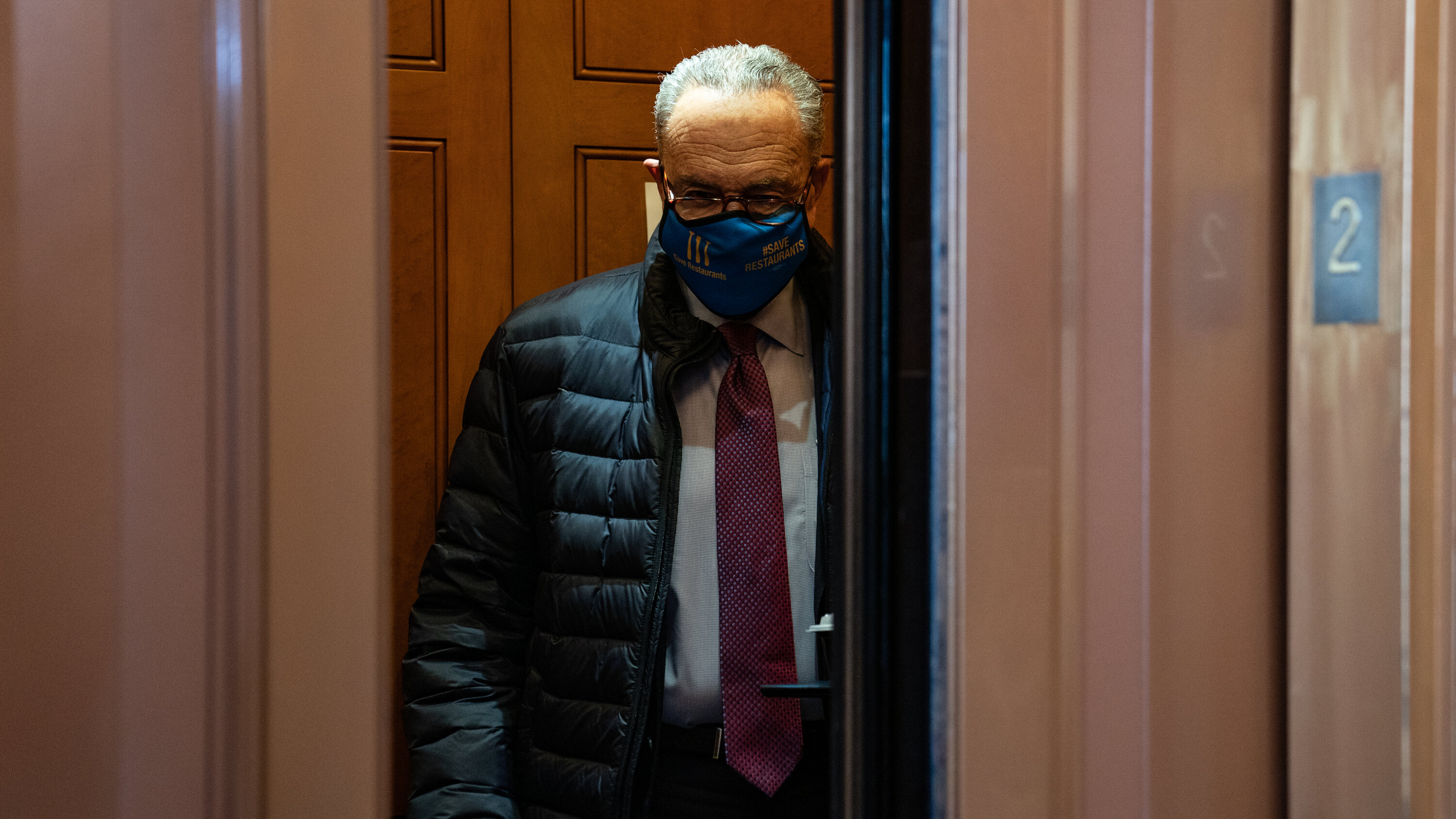
President Biden’s $1.9 trillion stimulus package ground to a standstill in the Senate on Friday, as Democrats haggled among themselves over the size and duration of federal unemployment payments that are a crucial piece of the plan.
Top Democrats, working to preserve moderate support for the package, had planned to drop their effort to increase a federal unemployment payment from $300 a week to $400, but extend it for an additional month, through Oct. 4, hoping that the concession would keep the pandemic aid plan on track.
But it appeared that Senator Joe Manchin III of West Virginia, a centrist whose support they need to maneuver the plan through the 50-50 Senate where all Republicans are opposed, remained unsatisfied.
The impasse halted the measure in its tracks just as the Senate had begun voting on proposed changes. What was supposed to have been a 15-minute vote on a minimum-wage increase stretched for longer than three hours as Democrats stalled for time, huddling on the Senate floor in search of a solution to break the impasse.
With the existing $300-a-week payments set to lapse on March 14, Mr. Biden’s stimulus proposal and the House bill that passed last weekend to implement it would increase the jobless aid to $400 weekly and extend it through the end of August.
But some moderate Senate Democrats are opposed to raising the amount, while other Democrats were concerned about the possibility that the benefits could lapse when the chamber is typically on recess and out of Washington. The revision Democrats had devised would address both issues, as well as adding a provision to make a large portion of 2020 jobless benefits tax-free.
In a brief interview, Senator Ron Wyden, Democrat of Oregon and the chairman of the Finance Committee, said the change “avoids the August cliff, secures tax forgiveness — preventing what I call the unexpected unemployment tax surprise — and keeps the caucus together.”
It was aimed at appeasing centrist Democrats who might otherwise have been tempted to vote for a Republican amendment by Senator Rob Portman of Ohio to keep the unemployment benefit at $300 per week — extending it until July but omitting any tax sweeteners — thus sapping support for the bill among other Democrats. But on Friday, Mr. Manchin did not appear ready to accept the alternative.
The White House had signaled support for the alternative, with Ron Klain, the chief of staff, tweeting, “This compromise is a great result.”
The proposal, introduced by Senator Tom Carper of Delaware, was just one of dozens of amendments the Senate was set to consider on Friday as it made its way through a marathon session of rapid-fire votes. The vote-a-rama, as it is known, could stretch long past midnight as Republicans battle against the bill, paving the way for a Senate vote to pass the stimulus plan as early as Saturday.
The unemployment provision would forgive up to $10,200 in taxes on unemployment benefits received through in 2020. Mr. Wyden, who was among those pushing to increase the unemployment payment to $400, said on the Senate floor that he was “really hoping this brings all sides of the Senate together.”
Democrats are racing against the clock, as some Americans have already begun to file their taxes and unemployment benefits are set to begin lapsing next weekend. The agreement would also extend tax rules regarding excess business loss limitations for one additional year, through 2026.
Hiring picked up last month as states lifted restrictions and stepped up vaccination efforts, with the government reporting on Friday that the American economy added 379,000 jobs last month.
The pace of hiring in February was an unexpectedly large improvement over the gains made in January. It was also the strongest showing since October.
But there are still about 9.5 million fewer jobs today than a year ago. Congress is considering a $1.9 trillion package of pandemic relief intended to carry struggling households and businesses through the coming months.
“What we’re seeing is broad, slow gains,” said Julia Pollak, an economist at the online job site ZipRecruiter. “It’s consistent with a slow reawakening of the labor market after a winter hibernation.”
The unemployment rate in February was 6.2 percent, down from the previous month’s rate of 6.3 percent. But as the Federal Reserve and top administration officials have emphasized, that number understates the extent of the damage.
Most of the February gains came in the leisure and hospitality industries, including restaurant and bars, which have been particularly hard hit by the pandemic. “There’s still a long way to go,” Ms. Pollak said, “but thank goodness it’s moving in the right direction and not continuing to hemorrhage jobs. The industry is a first rung on the ladder and employs so many young people.”
The retail and manufacturing sectors posted small gains. Losses in employment by state and local governments — mostly in education — pared the overall increase, however.
Leisure and hospitality saw gains, but state and local governments lost jobs
Cumulative change in jobs since before the pandemic, by industry
By Ella Koeze·Seasonally adjusted·Source: Bureau of Labor Statistics
More than four million people have quit the labor force in the last year, including those sidelined because of child care and other family responsibilities or health concerns. They are not included in the official jobless count.
The impact has also been uneven. The share of Black women who have left the labor force is more than twice as high as the share of white men.
“We’re still in a pandemic economy,” said Julia Coronado, founder of MacroPolicy Perspectives and a former Federal Reserve economist. “Millions of people are looking for work and willing to work, but they are constrained from working.”
Millions of workers are still relying on unemployment benefits and other government assistance, and first-time jobless claims rose last week, but analysts have offered increasingly optimistic forecasts for growth later in the year.
Recruiting sites have had an increase in job postings in recent weeks. Tom Gimbel, chief executive of LaSalle Network, a Chicago staffing firm, said the employers he speaks to are “absolutely ready to hire.”
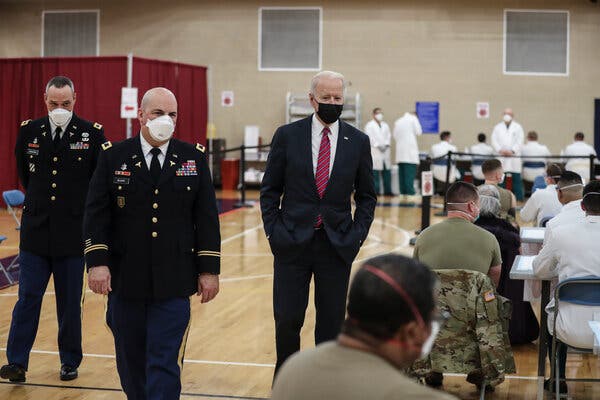
President Biden is enjoying a level of popularity his poll-obsessed predecessor never came close to achieving — a 60 percent approval rating — with 70 percent of Americans expressing support for his handling of the coronavirus pandemic, according to a new poll.
Despite enduring and stark partisan divisions, 44 percent of Republicans approve of Mr. Biden’s actions prioritizing the fight against the virus, according to an Associated Press-NORC Center for Public Affairs Research poll released early Friday.
As a temperature check of the current national mood, the poll suggests that Republican lawmakers in Washington, who have united to oppose Mr. Biden’s $1.9 trillion coronavirus relief bill, are not swaying public opinion, despite their efforts to alter or delay its passage.
In all, 22 percent of Republicans approve of Mr. Biden’s performance, suggesting small but substantial gains among his most hard-core opponents that could give him added political leverage, paving the way for the possibility of a big bipartisan deal on infrastructure.
Mr. Biden’s overall approval among Democrats is a solid 94 percent, despite recent criticism from progressives.
Mr. Trump sustained a similar level of support from his base, but is the only president in the history of modern polling to never post an aggregate approval rating above 50 percent. His level of support has sunk, to an average of about 38 percent, after the Jan. 6 attack on the Capitol.
Friday’s poll is a bit sunnier than other recent national surveys that show a slight decrease in support for Mr. Biden as the fight over his relief package heats up on Capitol Hill. A RealClearPolitics aggregation of polls put his approval rating at 53.4 percent, not factoring in the A.P. poll.
Mr. Biden’s grades on the economy were lower than his ratings on other issues, the poll found. His approval on pocketbook issues was 55 percent. Only 17 percent of Republicans, a group that gave former President Donald J. Trump high marks for his handling of the economy even during the pandemic-related downturn, approved of Mr. Biden’s approach to the economy.
The A.P. poll, unsurprisingly, found that the atmosphere of hyper partisanship exacerbated by Mr. Trump’s four years of provocation is not subsiding under Mr. Biden, and that people in both parties tend to interpret fact through the filter of ideology.
Americans’ views on the economy have shifted dramatically even though many basic economic statistics have budged little, if at all.
In December, 67 percent of Republicans and just 15 percent of Democrats described the economy as “good,” according to an A.P. poll taken at the time. Now, 35 percent of Republicans and 41 percent of Democrats describe the economy in positive terms.
The poll, which surveyed 1,434 adults between Feb. 23 and March 1, has an overall sampling error of plus or minus 3.4 percentage points.

A small group of scientists and others who believe the novel coronavirus that spawned the pandemic could have originated from a lab leak or accident is calling for an inquiry independent of the World Health Organization’s team of independent experts sent to China last month.
While many scientists involved in researching the origins of the virus continue to assert that the SARS-CoV-2 pandemic almost certainly began with a leap from bats to an intermediate animal and then to humans, other theories persist and have gained new visibility with the W.H.O.-led team of experts’ recent visit to China.
Officials with the W.H.O. have said in recent interviews that it was “extremely unlikely” but not impossible that the spread of the virus was linked to some sort of lab accident.
In an open letter, first reported in The Wall Street Journal and Le Monde, the French newspaper, the signers list what they cast as flaws in the joint W.H.O.-China inquiry, and argue that it could not adequately address the possibility that the virus leaked from a lab.
Many of those who signed the letter were based in France. Richard Ebright, a molecular biologist at Rutgers University and one of the scientists who signed the letter, said it grew out of a series of online discussions among scientists, policy experts and others who came to be known informally as the Paris group.
Dr. Ebright said that no one in the group thought that the virus had been intentionally created as a weapon, but they were all convinced that an origin in a lab through research or by accidental infection was as likely as a spillover occurring in nature from animals to humans.
Asked to respond to the letter, Tarik Jasarevic, a spokesman for the W.H.O., replied in an email that the team of experts that had gone to China “is working on its full report as well as an accompanying summary report, which we understand will be issued simultaneously in a couple of weeks.”

Cyprus has announced a plan to allow vaccinated residents of Britain to visit the island beginning in May, a further signal that countries, particular those dependent on tourism, could resort to inoculation certificates to reopen their borders.
Savvas Perdios, the deputy tourism minister for Cyprus, told the Cyprus News Agency that, as of May 1, British citizens who had received two doses of a vaccine approved by the European Union’s drug regulator would be allowed to travel to the Mediterranean island without having to be tested for the coronavirus or to isolate on arrival.
Some European nations with economies that are heavily reliant on tourism, such as Spain, have advocated for a vaccine certificate program to be created at the European Union level but have also said that they could adopt bilateral systems if no broader agreement is reached. The European Commission, the bloc’s executive arm, this week announced plans to create a “digital green pass” to facilitate safe travel among member nations, though that system is expected to take at least three months.
The British authorities have said that talks on opening up travel are underway with a number of countries, including some in the European Union.
Matt Hancock, the British health secretary, said this week, “If another country wants to say that you need to have been vaccinated with a recognized vaccine to travel there, we want to enable Brits to be able to take that journey.”
More than a million travelers from Britain visited Cyprus in 2019, representing by far the highest number of international tourists to the island, according to official statistics.
Despite the green light from Cyprus, international travel from Britain is forbidden for leisure purposes until at least May 17 under the current lockdown rules, and it is unclear how many British residents will have received two vaccine doses by then. Fewer than a million people in Britain have so far been fully vaccinated.
In other news around the world:
-
South Korea’s drug safety agency approved the Pfizer-BioNTech vaccine on Friday and doses for about 23 million people are expected to begin arriving this month, the news agency Yonhap reported. The country, which has a population of about 51 million, began its vaccination program last week as part of a plan to achieve herd immunity by November. South Korea approved the Oxford-AstraZeneca vaccine in February and expects to receive more than two million doses through Covax, an international group that has negotiated for coronavirus shots.
-
Prime Minister Jacinda Ardern of New Zealand has said that a snap lockdown imposed last week on the country’s largest city, Auckland, will end on Sunday morning. Social gatherings will be capped at 100 people and other restrictions will remain in place. The lockdown was imposed after the authorities discovered an untraceable case. They have since conducted more than 50,000 tests and tracked more than 6,000 contacts.
-
Japan has extended its state of emergency for the greater Tokyo metropolitan area until March 21, the government announced on Friday, according to the national broadcaster NHK. Emergency orders were lifted in six other prefectures. The restrictions, which include an order for restaurants and bars to close by 8 p.m., had been scheduled to end on Sunday.
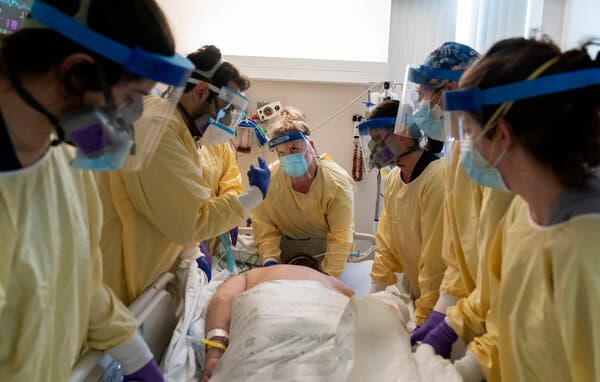
After a quiet summer, doctors at Rhode Island Hospital began seeing one or two patients with Covid-19 on each shift — and soon three. Then four.
Cases climbed steadily from September until early December, when Rhode Island earned the dubious distinction of having more cases and deaths per 100,000 people than any other state in the country. The case rate still puts it among the top five states.
Where did this tightly knit state go wrong? Former Gov. Gina Raimondo’s “pauses” on economic activity were short-lived and partial, leaving open indoor dining, shopping malls and bowling alleys. But the shutdowns were no patchier than those in many other states.
Until late summer, she was lauded for reining in the virus. Even now, few residents blame her for the bleak numbers.
Experts point instead to myriad other factors, all of which have played out elsewhere in the country but converged into a bigger crisis in Rhode Island.
The fall chill sent people indoors, where risk from the virus is highest, and the holidays brought people together. Rhode Island is tiny — you can traverse it in 45 minutes. But crammed into that smallish area are a million people — a population density second only to that of New Jersey.
Apart from its density, Rhode Island has a high percentage of older residents in nursing homes, accounting for the bulk of deaths. Packed into the state are multiple urban areas — Central Falls, Pawtucket, Providence — where language barriers, mistrust and jobs have left immigrant families in multigenerational homes particularly vulnerable. The state is also home to multiple colleges that set off chains of infection in the early fall.
As in most of the country, the Latino community has borne the brunt of the epidemic. In Rhode Island, Latinos have 6.7 times the risk for hospitalization and 2.5 times the risk of death, compared with white people.
The state’s epidemic has been disastrous for immigrant families in multigenerational households.
Workplace exposures have especially hurt the Latino and Cape Verdean community, many of whom hold jobs that cannot be done from home. But in state surveys, it also became obvious that people were still holding get-togethers of 15 to 20 people even as the virus spread, said Dr. James McDonald, medical director of the Covid-19 unit at the Rhode Island Department of Health.
“People weren’t willing to live differently during the pandemic,” he said.
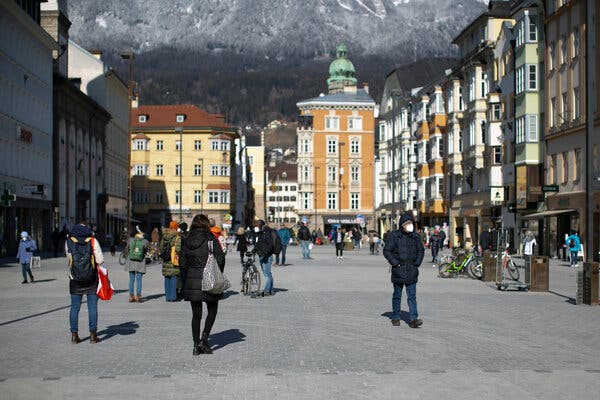
European authorities will offer a coronavirus vaccine to every adult in an Austrian district battered by a surge in infections to determine how effective the inoculation is against the variant first found in South Africa.
Starting next week, everyone aged 16 and older living in the Schwaz district, near the western Austrian city of Innsbruck, will be eligible for free shots of the vaccine from Pfizer-BioNTech, as part of the unique drive to learn more about fighting the variant.
The study in Austria is part of a much broader global effort to answer a crucial question as the virus mutates and new variants emerge: Do vaccinations designed last year work against more recent mutations? If not, scientists will have to keep developing new versions of the inoculations.
Laboratory studies have shown that some vaccines that work well against earlier variants are less effective — though they still offer significant protection — against the variant known as B.1.351, which was first found in South Africa in December and has become the dominant one there.
Real-world tests of those findings are still needed, and some combinations of variants and vaccines have not yet been tested, even in lab settings.
Authorities in the Schwaz district, in the state of Tyrol, appealed on Thursday to residents to sign up for their vaccines by March 8, to allow for enough doses to be ordered and delivered for the study. More than 20,000 residents, roughly a third of all those eligible, registered in the first 24 hours, the authorities said.
Earlier this week, Ursula von der Leyen, president of the European Commission, agreed to allocate 100,000 extra doses of the vaccine to Austria, in exchange for allowing a multinational team of scientists to collect data from the mass vaccination in Tyrol. The region has seen one of the worst outbreaks of the variant in Europe and Austria’s chancellor, Sebastian Kurz, had been lobbying the European Union for extra doses to try to stop its spread.
“Our goal is to be able to massively halt, if not eradicate, the South African variant,” Günther Platter, the governor of Tyrol, said on Wednesday. “We want to protect the people from this variant.”
But the success of the project is dependent on everyone being willing to take part. Officials hope to begin administering shots on March 11.

China is requiring some travelers arriving from overseas to receive an invasive anal swab test as part of its coronavirus containment measures, a move that has outraged and shocked several foreign governments.
Japanese officials said on Monday that they had formally asked China to exempt Japanese citizens from the test, adding that some who had received it complained of “psychological distress.” And the United States State Department last moth said it had registered a protest with the Chinese government after some of its diplomats were forced to undergo anal swabs, though Chinese officials denied that.
It is not clear how many such swabs have been administered or who is subject to them. Chinese state media has acknowledged that some arrivals to cities including Beijing and Shanghai are required to take the tests, though the reports said the requirements might vary depending on whether the travelers were deemed to be high-risk.
Chinese experts have suggested that traces of the virus may survive longer in the anus than in the respiratory tract and that samples of the former may prevent false negatives. China has imposed some of the strictest containment measures in the world, including barring most foreign arrivals, and has largely suppressed the epidemic.
Lu Hongzhou, an infectious disease specialist at Fudan University in Shanghai, told the state-controlled Global Times tabloid that nasal or throat swabs could cause “uncomfortable reactions,” leading to subpar samples. He acknowledged that fecal samples could replace anal swabs, to prevent similar discomfort.
But other experts — including in China — have questioned the need for anal samples. The Global Times quoted another expert, Yang Zhanqiu, as saying that nasal and throat swabs are still the most effective because the virus is contracted through the respiratory tract.
Benjamin Cowling, a public health professor at the University of Hong Kong, said in an interview that even if someone did test positive on an anal swab but not a respiratory one, he or she would likely not be very contagious.
“The value of detecting people with the virus is to stop transmission,” Professor Cowling said. “If someone has got an infection but they’re not contagious to anyone else, we didn’t need to detect that person.”
A spokesman for the Chinese Foreign Ministry said this week that the government would make “science-based adjustments” to its containment policies.
Professor Cowling said he did not know what the scientific rationale was behind the existing policies. “I presume there’s some evidence leading to this decision, but I haven’t seen that evidence,” he said.

The San Diego Zoo has given nine apes an experimental coronavirus vaccine developed by Zoetis, a major veterinary pharmaceuticals company.
In January, a troop of gorillas at the zoo’s Safari Park tested positive for the virus. All are recovering, but even so, the zoo requested help from Zoetis in vaccinating other apes. The company provided an experimental vaccine that was initially developed for pets and is now being tested in mink.
Nadine Lamberski, a conservation and wildlife health officer at San Diego Zoo Global, said the zoo vaccinated four orangutans and five bonobos with the experimental vaccine, which is not designed for use in humans. Among the vaccinated orangutans was an ape named Karen, who made history in 1994 when she became the first orangutan to have open-heart surgery.
Dr. Lamberski said one gorilla at the zoo was also scheduled to be vaccinated, but the gorillas at the wildlife park were a lower priority because they had already tested positive for infection and had recovered. She said she would vaccinate the gorillas at the wildlife park if the zoo received more doses of the vaccine.
Mahesh Kumar, senior vice president of global biologics for Zoetis, said the company is increasing production, primarily for its pursuit of a license for a mink vaccine, and will provide more doses to the San Diego and other zoos when possible. “We have already received a number of requests,” he said.
Infection of apes is a major concern for zoos and conservationists. They easily fall prey to human respiratory infections, and common cold viruses have caused deadly outbreaks in chimpanzees in Africa. Genome research has suggested that chimpanzees, gorillas and other apes will be susceptible to SARS-CoV-2, the virus that has caused the pandemic. Lab researchers are using some monkeys, like macaques, to test drugs and vaccines and develop new treatments for the virus.
Scientists are worrying not just about the danger the virus poses to great apes and other animals, but also about the potential for the virus to gain a foothold in a wild animal population that could become a permanent reservoir and emerge at a later date to reinfect humans.
Infections in farmed mink have produced the biggest scare so far. When Danish mink farms were devastated by the virus, which can kill mink just as it kills people, a mutated form of the virus emerged from the mink and reinfected humans. That variant showed resistance to some antibodies in laboratory studies, raising suspicion that vaccines might be less effective against it.
That virus variant has not been found in humans since November, according to the World Health Organization. But other variants have emerged in people in several countries, proving that the virus can become more contagious and in some cases can diminish the effectiveness of some vaccines.
Denmark ended up killing as many as 17 million mink — effectively wiping out its mink farming industry. In the United States, thousands of mink have died, and one wild mink has tested positive for the virus.
Although many animals, including dogs, domestic cats, and big cats in zoos, have become infected by the virus through natural spread, and others have been infected in laboratory experiments, scientists say that widespread testing has yet to find the virus in any animal in the wild other than the one mink.
National Geographic first reported the vaccination of the apes at the San Diego Zoo.
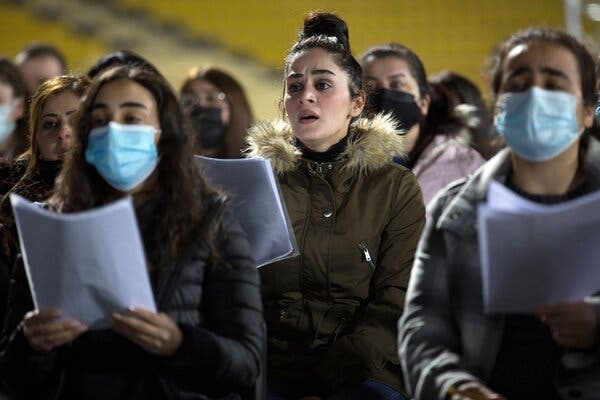
After more than a year cooped up behind the Vatican walls, Francis traveled to Baghdad on Friday at a tense time in the pandemic, sending a message that flies in the face of many public health guidelines.
In his weekly address on Wednesday, the pope said he would not be deterred.
“I ask that you accompany this apostolic trip with prayer so that it can occur in the best way possible, bear the hoped-for fruit,” he said. “The Iraqi people await us.”
Francis, who was vaccinated in mid-January, has urged wealthy countries to give vaccine doses to poorer ones, and called a refusal to vaccinate “suicidal.”
The pope’s entourage has also been inoculated.
The possibility that Francis, who is 84, might inadvertently endanger an Iraqi population with practically no access to vaccines is not lost on his allies back in Rome.
“There is this concern that the pope’s visit not put the people’s health at risk — this is evident,” said the Rev. Antonio Spadaro, a Jesuit priest and close ally of Francis. “There is an awareness of the problem.”
The Vatican insisted that the trip would be a safe, socially distanced and sober visit devoid of the usual fanfare. A Vatican spokesman also played down the number of cases in Iraq when reporters asked how Francis could justify not delaying the trip.
Supporters worry that the pope’s goals for the visit could be eclipsed by any indication that he is contributing to the spread of the coronavirus by staging events where social distancing is hard to enforce.

For much of the winter, Meryl Gordon worried about the people caring for her 95-year-old mother, who was rehabbing in a Manhattan nursing home after surgery for a broken hip.
“Every week they sent out a note to families about how many staff members had positive Covid tests,” said Ms. Gordon, a biographer and professor at New York University. “It was a source of tremendous anxiety.”
Ms. Gordon feels reassured now that her mother is fully vaccinated and has returned to her assisted living facility. But what about the two home care aides who help her 98-year-old father, David, in his Upper West Side apartment?
Neither has agreed to be vaccinated. David Gordon’s doctor has advised him to delay vaccination himself because of his past allergic reactions.
Ms. Gordon has not insisted that the caregivers receive vaccinations. “You’re reluctant to do something that could cause you to lose the people you rely on,” she said. But she remains uneasy.
It’s a question that many long-term care employers, from individual families to big national companies, are confronting as vaccines become more available, although not available enough: In a pandemic, can they require vaccination for those who care for very vulnerable older adults? Should they?
Some employers aren’t waiting. Atria Senior Living, one of the nation’s largest assisted living chains, has announced that by May 1 all staff members must be fully vaccinated.
Silverado, a small chain of dementia care homes, most on the West Coast, mandated vaccination by March 1. Juniper Communities, which operates 22 facilities in four states, has also adopted a mandate.
“We felt it was the best way to protect people, not just our residents but our team members and their families,” said Lynne Katzmann, Juniper’s chief executive. Of the company’s nearly 1,300 employees, “about 30 individuals have self-terminated” because of the vaccination requirement, she reported.
Juniper’s experience supports what public health experts have said for years: Vaccine mandates, like those that many health care organizations have established for the flu vaccine, remain contentious — but they do increase vaccination rates. As of Feb. 25, 97.7 percent of Juniper residents had received two vaccine doses, and so had 96 percent of its staff members.
That stands in stark contrast to staff vaccinations in many facilities. The Centers for Disease Control and Prevention has reported that during the first month of vaccine clinics in nursing homes, only 37.5 percent of staff members received the first shot, along with 77.8 percent of residents.



